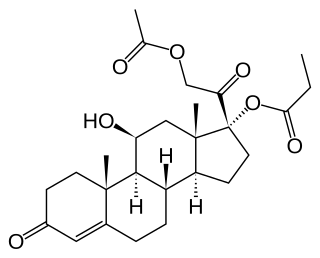Related Research Articles

Corticosteroids are a class of steroid hormones that are produced in the adrenal cortex of vertebrates, as well as the synthetic analogues of these hormones. Two main classes of corticosteroids, glucocorticoids and mineralocorticoids, are involved in a wide range of physiological processes, including stress response, immune response, and regulation of inflammation, carbohydrate metabolism, protein catabolism, blood electrolyte levels, and behavior.

Hydrocortisone is the name for the hormone cortisol when supplied as a medication. Uses include conditions such as adrenocortical insufficiency, adrenogenital syndrome, high blood calcium, thyroiditis, rheumatoid arthritis, dermatitis, asthma, and COPD. It is the treatment of choice for adrenocortical insufficiency. It can be given by mouth, topically, or by injection. Stopping treatment after long-term use should be done slowly.
ATC code A01Stomatological preparations is a therapeutic subgroup of the Anatomical Therapeutic Chemical Classification System, a system of alphanumeric codes developed by the World Health Organization (WHO) for the classification of drugs and other medical products. Subgroup A01 is part of the anatomical group A Alimentary tract and metabolism.
ATC code A07Antidiarrheals, intestinal anti-inflammatory/anti-infective agents is a therapeutic subgroup of the Anatomical Therapeutic Chemical Classification System, a system of alphanumeric codes developed by the World Health Organization (WHO) for the classification of drugs and other medical products. Subgroup A07 is part of the anatomical group A Alimentary tract and metabolism.
ATC code D01Antifungals for dermatological use is a therapeutic subgroup of the Anatomical Therapeutic Chemical Classification System, a system of alphanumeric codes developed by the World Health Organization (WHO) for the classification of drugs and other medical products. Subgroup D01 is part of the anatomical group D Dermatologicals.
ATC code D07Corticosteroids, dermatological preparations is a therapeutic subgroup of the Anatomical Therapeutic Chemical Classification System, a system of alphanumeric codes developed by the World Health Organization (WHO) for the classification of drugs and other medical products. Subgroup D07 is part of the anatomical group D Dermatologicals.
Miconazole, sold under the brand name Monistat among others, is an antifungal medication used to treat ring worm, pityriasis versicolor, and yeast infections of the skin or vagina. It is used for ring worm of the body, groin, and feet. It is applied to the skin or vagina as a cream or ointment.
ATC code S02Otologicals is a therapeutic subgroup of the Anatomical Therapeutic Chemical Classification System, a system of alphanumeric codes developed by the World Health Organization (WHO) for the classification of drugs and other medical products. Subgroup S02 is part of the anatomical group S Sensory organs.

Desonide (INN) is a low-potency topical corticosteroid anti-inflammatory that has been available since the 1970s. It is primarily used to treat atopic dermatitis (eczema), seborrheic dermatitis, contact dermatitis and psoriasis in both adults and children. It has a fairly good safety profile and is available as a cream, ointment, lotion, and as a foam under the tradename Verdeso Foam. Other trade names for creams, lotions, and ointments include Tridesilon, DesOwen, Desonate. It is a group VI corticosteroid under US classification, the second least potent group.

Actavis Generics is a global pharmaceutical company focused on acquiring, developing, manufacturing and marketing branded pharmaceuticals, generic and over-the-counter medicines, and biologic products. Actavis has a commercial presence across approximately 100 countries. The company has global headquarters in Dublin, Ireland and administrative headquarters in Parsippany-Troy Hills, New Jersey, United States.

Loteprednol is a topical corticosteroid used to treat inflammations of the eye. It is marketed by Bausch and Lomb as Lotemax and Loterex.

Hydrocortisone buteprate, also known as hydrocortisone probutate and as hydrocortisone butyrate propionate, is a topical corticosteroid. It is an ester of hydrocortisone (cortisol) with butyric acid and propionic acid.

Hydrocortisone aceponate is a veterinary corticosteroid that is used in form of creams for the treatment of various dermatoses. It is an ester of hydrocortisone (cortisol) with acetic acid and propionic acid.
Neomycin/polymyxin B/hydrocortisone, sold under the brand Otosporin among others, is a medication used to treat otitis externa and certain eye disorders. It consists of the antibiotics neomycin and polymyxin B, and the steroid hydrocortisone. It is used as an ear drop or eye drop.
Acetic acid/hydrocortisone is a commonly used combination drug to treat infections of the outer ear and ear canal. Branded as Vosol HC and Acetasol HC, it combines the antibacterial and antifungal action of acetic acid with the anti-inflammatory functions of hydrocortisone.
Critical illness–related corticosteroid insufficiency is a form of adrenal insufficiency in critically ill patients who have blood corticosteroid levels which are inadequate for the severe stress response they experience. Combined with decreased glucocorticoid receptor sensitivity and tissue response to corticosteroids, this adrenal insufficiency constitutes a negative prognostic factor for intensive care patients.
Topical steroids are the topical forms of corticosteroids. Topical steroids are the most commonly prescribed topical medications for the treatment of rash, eczema, and dermatitis. Topical steroids have anti-inflammatory properties and are classified based on their skin vasoconstrictive abilities. There are numerous topical steroid products. All the preparations in each class have the same anti-inflammatory properties but essentially differ in base and price.
Hydrocortisone/oxytetracycline is a combination drug, consisting of the anti-inflammatory drug hydrocortisone and the antibiotic drug oxytetracycline.

Domoprednate is a synthetic glucocorticoid corticosteroid which was developed in the late 1970s and 1980s.
References
- ↑ Hydrocortisone/Miconazole nitrate at NHS Choices by National Health Service. Retrieved October, 2012